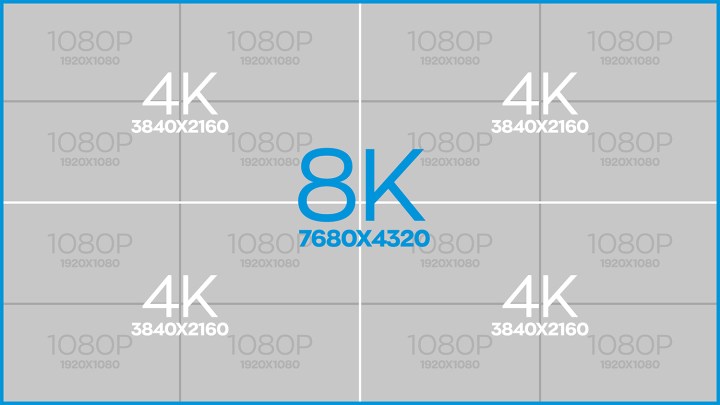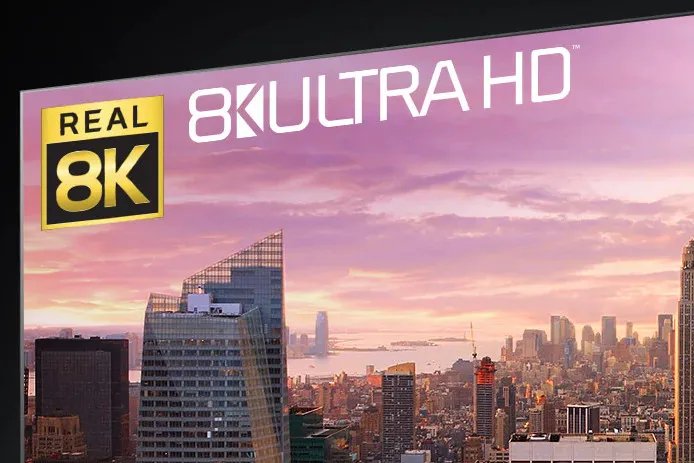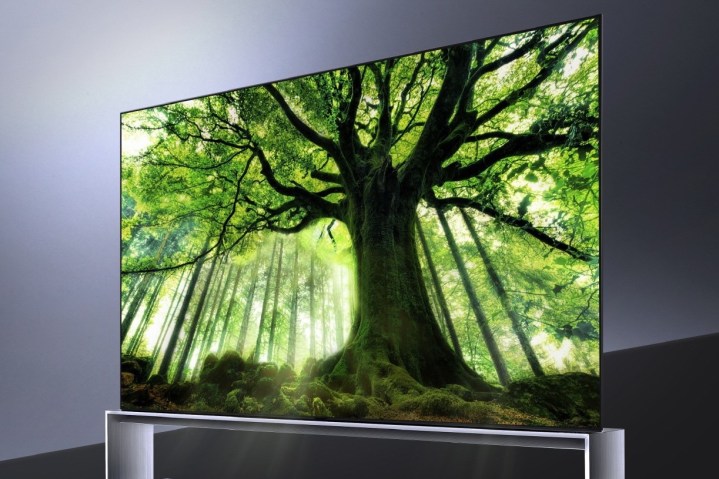While a new 8K TV might not be on everyone’s shopping list just yet, 2020 is ramping up to be the first year that you’ll be able to choose from more than just one or two of these super-high-resolution TVs. More choice is great, but it also means that manufacturers will be actively promoting why their 8K TVs are better than the competition.
They’ll do that, in part, through the use of a growing number of labels and certifications, designed to assure buyers that they’re getting the best 8K TV. One of these labels is “Real 8K” and you’ll see it prominently displayed on 8K TVs made by LG. But what does Real 8K mean and why does it only show up on 8K TVs made by LG?
Here’s the straight dope on Real 8K.
Resolution by the numbers

We’ll get to LG’s Real 8K label in a moment, but first, a quick 101 on resolution:
TV resolution is usually expressed in two different ways. The first is the mathematical-looking X by Y format, which shows you the number of vertical lines (measured horizontally) and the number of horizontal lines (measured vertically) that make up a TV’s image. In the case of 8K resolution, this looks like 7680 x 4320. If you multiply those two numbers, you end up with the total number of individual pixels, which in this case is 33,177,600 (wow!).
The second and more common way is to round up the number of vertical lines and use that as a shorthand, which how we get “4K” (from 3840 x 2160) and now “8K” (from 7680 x 4320). That shorthand doesn’t really do justice to the difference between these two resolutions, however, because 8K sounds like it’s double the resolution of 4K when it is, in fact, four times the resolution of 4K.
Reading between the lines
- 1. LG NanoCell 8K TV
- 2. Competing 8K QLED TV
Despite that potentially misleading name, most people find it pretty easy to understand that 8K means more resolution than 4K. But it turns out that the sheer amount of resolution a TV can display in terms of lines or pixels is only one part of the resolution story.
For several years now, the International Committee for Display Metrology (ICDM) — the folks who establish the measurements by which displays are objectively judged — has been placing an emphasis on a different way of judging a TV’s resolution. Instead of simply declaring the number of pixels and calling it a day, the committee now also looks at something called Contrast Modulation or CM.
CM is a measurement of how precisely one individual pixel can be visually distinguished from its neighboring pixels. CM works on a percentage scale of 0-100, where zero means that neighboring pixels totally spill their brightness and color into one another, and 100 means that each pixel perfectly preserves its own color and brightness and those attributes never affect the adjacent pixels. In the images above, the one on the left exhibits a high CM value, while the one on the right has a much lower CM value.
A lack of CM is most noticeable when looking at high-frequency edges. These are areas of the screen where high-contrast patterns are displayed like black text on a white background or a close-up shot of facial hair.
In theory, any display with a CM value of 100 — regardless of its actual resolution — provides the sharpest, most detailed image possible.
Battle lines are drawn

Now we’re finally at the starting point for LG’s Real 8K label. Back in 2019, there were effectively only two manufacturers selling 8K TVs: Samsung and LG. Samsung had arrived at the 8K table first with its QLED-based TVs, and LG showed up second, using its OLED-based displays. Both companies could claim 8K resolution based on the vertical and horizontal numbers, but Samsung’s engineering meant that its 8K TVs exhibited relatively low CM values — some as low as 12%.
LG’s 8K TVs, on the other hand, possessed a remarkably high CM value of 90%, in part due to the inherently high CM nature of OLED, but LG also claims this number for its NanoCell 8K TVs. This created a natural opportunity for LG to tout the sharpness and detail superiority of its 8K TVs. Instead of talking about its TV’s CM values directly, which it rightly felt was about as exciting as dust to the average buyer, it created the “Real 8K” label. The intent is to grab people’s attention, and get them to ask themselves (and hopefully well-informed sales staff at their local retailer), “what is Real 8K?”
As soon as that conversation begins, LG’s hope is that it will then have the opportunity to explain the benefits of its high CM values.
Why have I never heard of CM?
Good question. We’ve been paying attention to the published specifications of TVs for almost two decades. Unlike items such as contrast ratio, peak brightness, refresh rate, or even color gamut, we’ve seldom run across contrast modulation on a manufacturer’s list of specs.
You might think this is because CM isn’t that important in the real world, or that it’s something only hardcore measurement nerds care about. As it turns out, back in 2016, Samsung itself was heralding the importance of CM. At the time, it was touting its CM superiority over LG’s TVs — an inverse of today’s situation — which suggests that manufacturers agree that CM is important, but they only like to draw attention to it when their TVs possess a CM advantage over the competition.
Who else thinks CM matters?

Contrast modulation isn’t just the domain of display measurement professionals. It’s also recognized by the Consumer Technology Association (CTA), which is the industry group that publishes the most widely-used set of specifications for household TVs and other devices. In the CTA’s specifications for 8K TVs, it mandates a minimum CM value of 50% among other qualifying criteria.
Any 8K TV that fails to meet these specs is not allowed to bear the CTA’s official 8K logo, which in part explains LG’s declaration that its 8K TVs are Real 8K TVs — it’s a not-so-subtle swipe at Samsung or any other manufacturer that produces an 8K TV with a low CM value.
Is Real 8K just about contrast modulation?

CM is definitely a big part of LG’s claim of having Real 8K, but the label actually refers to a combination of attributes. The three main components of Real 8K are: High contrast modulation, high-quality video processing of both 4K and 8K video sources, and the ability to handle this content via the newest input standard (HDMI 2.1).
Due to the somewhat subjective nature of “high-quality video processing,” LG claims the Real 8K label isn’t a specification or even a standard. That’s handy because as other manufacturers offer up high-CM value 8K TVs, LG won’t need to relinquish the Real 8K label or share it with other companies. It will always stand apart as LG’s in-house declaration of 8K TV quality.
Can you tell the difference between Real 8K TVs and other 8K TVs?

If Real 8K TVs are worth calling out, there should be a tangible benefit to buyers. There should be a noticeable difference between a model that bears a Real 8K TV label and one that does not.
This is where things get a bit dicey. So far, we haven’t had an opportunity to look at one of LG’s flagship “Real 8K” TVs — like the awesome Z9 — side by side with a non-LG 8K TV. That time will surely come, but for now, we simply can’t tell you if the advantages of a super-high CM display can be appreciated under normal viewing conditions.
This unanswered question is further complicated by the fact that most of the 8K TVs coming onto the market in 2020 will meet or exceed the CTA’s minimum CM criteria. Comparing one of LG’s TVs to these models will likely produce a less noticeable difference or indeed, no difference at all. And yet, none of these TVs will bear LG’s Real 8K TV logo.
Do I need to buy a Real 8K TV?
No. As we pointed out earlier, the Real 8K label is an LG invention intended to raise buyers’ awareness of the fact that not all 8K TVs are created equal, with the hope that this will lead to a discussion about the importance of contrast modulation. But that doesn’t mean that only LG TVs bearing the Real 8K TV label are worth your consideration.
In fact, we would argue that if you’re going to pay attention to any label (instead of the recommendation of professional TV reviewers), it should be a label that’s based on a set of criteria that any TV can meet — like the CTA’s 8K Ultra HD label. It may not be a guarantee of an incredibly high specific measurement like LG’s CM claims, but it does act as a good baseline for all of the criteria that are important for an 8K TV to offer a good viewing experience.
So while we have given LG’s TVs high marks in the past and will likely continue to do so in the future (especially for its glorious OLED models), our opinion is that you should focus more on the overall quality of these TVs, and less on the label on the box.





